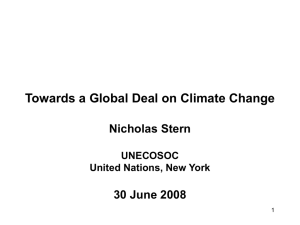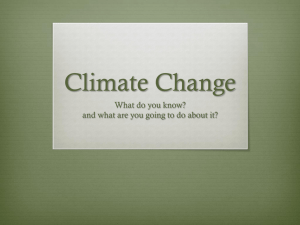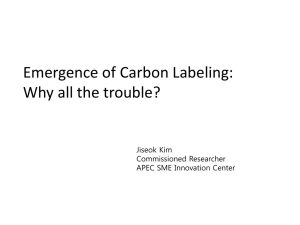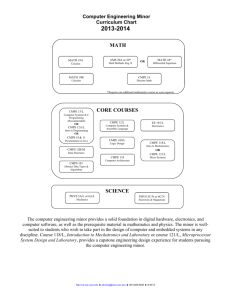Towards a Global Deal on Climate Change Nicholas Stern 26 June 2008
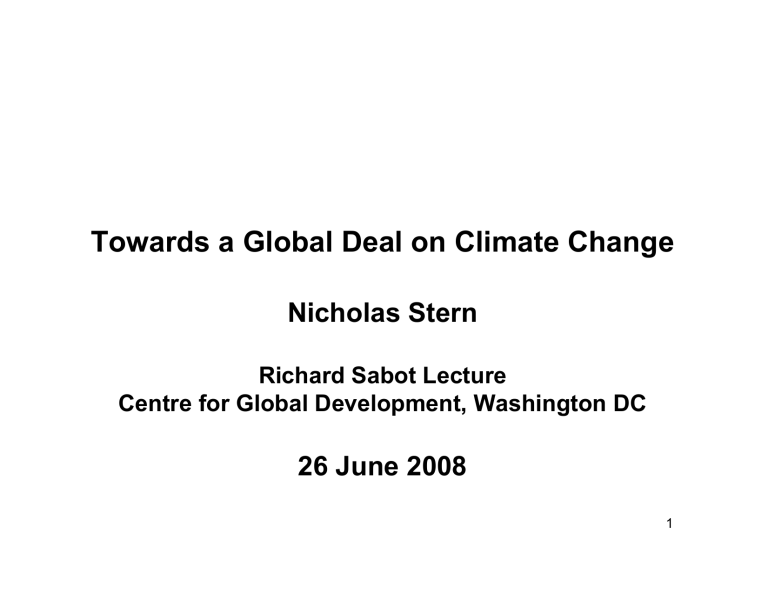
Towards a Global Deal on Climate Change
Nicholas Stern
Richard Sabot Lecture
Centre for Global Development, Washington DC
26 June 2008
1
Part One
Risks and Targets
2
‘Probabilities’ (in %) of exceeding a temperature increase at equilibrium
Stabilisation level
(in ppm CO
2 e)
450
500
550
650
750
2°C
78
96
99
100
100
Source: Hadley Centre: From Murphy et al. 2004
3°C
18
44
69
94
99
4°C
3
11
24
58
82
5°C
1
3
7
24
47
6°C
0
1
2
9
22
7°C
0
4
9
0
1
•Monte Carlo estimates from Hadley Centre
•Model ‘fairly cautious’
•Those who argue e.g. for stabilisation levels of 650ppm CO
2 e and above are accepting very big risks of a transformation of the planet
•Figures similar to IPCC AR4 (no probabilities in TAR) 3
Structure of argument on mitigation objectives (I)
• Risk of going above 5°C increase are very severe: e.g. would induce massive movements of population
• On basis of implied probabilities of temperature increase, dangerous to go beyond 550ppm CO
2 e
• Stabilisation to 550 or 500ppm CO
2 e ‛ buys’ sharp reduction in probabilities of dangerous temperature increases relative to BAU
• Cuts of 30-50% by 2050 required for target of stabilisation range
550- 500ppm CO
2 e
• Cost of action to get in range looks acceptable relative to reduction of risks and damages avoided : 1 or 2% of GDP
• Some aggregate formal modelling useful to inform damage estimates but loses key detail, sensitive to assumptions and implausible for optimisation analysis
4
Structure of argument on mitigation objectives (II)
• Whilst considerations of risk steer quantity targets (i.e. cuts), efficiency requires use of market mechanism to keep down costs
• These cuts would need a carbon price of $30 plus per tonne of CO
2 e; thus we have a “take” on marginal abatement costs
• This is in range of marginal social cost (MSC), for paths associated with 500-550ppm CO
2 e but MSC is very sensitive to ethical and structural assumptions
• Equity demands that rich countries take much bigger targets for cuts than poor. Trading can then provide flow of finance to developing countries
5
Part Two
Flows, Costs and Stern Review
One Year On
6
Delaying mitigation is dangerous and costly
100
90
80
70
60
50
40
30
20
10
0
2000 2010
Source: Stern Review
2020 2030 2040 2050
50GtCO2e
65GtCO2e
70GtCO2e
450ppm CO2e
500ppm CO2e (falling to
450ppm CO2e in 2150)
550ppm CO2e
Business as Usual
2060 2070 2080 2090 2100
7
Cost estimates
• Stern Review examined results from bottom-up (Ch 9) & top-down
(Ch 10) studies: concluded that world could stabilise below 550ppm
CO
2 e for around 1% of global GDP; stabilisation at 500ppm costs around 2%
• Subsequent analyses Edenhofer/IPCC top-down have indicated lower figures
• So too have bottom-up IEA and McKinsey
• Starting planning now with clear targets and good policies allows measured action and keeps costs down. Delayed decisions/actions
(or “slow ramp”), lack of clarity, bad policy will increase costs
• Associated co-benefits (energy security, reduced pollution) and opportunities (innovations, new markets)
• Importance of good policy: all countries; broad range of technologies; extensive use of price mechanism; support technological development and sharing
8
Reflections on costs and damages in
Stern Review analysis after one year
• Emphasis on risk avoidance rather than formal modelling well-founded
• Modelling without making risk central misses the point – both ethics and risk crucial : Stern Review damages averaged over space, time, outcomes :
5-20% GDP
• Probably under-estimated emission growth (growth of emissions from China and India particularly)
• Probably under-estimated risks of high-temperatures (omitted features in climate science modelling) and damages from high temperatures
(implausible ‛ overly linear’ extrapolations)
• Thus magnitude of avoided damages under-estimated
• With high inequality/risk aversion ( η between 1 and 2 say) and greater weights in damage tail find numbers similar to or larger than those of
Review in formal modelling
• Cost of action about right, perhaps on high side. But good policy is important 9
Discounting
• Non-marginal problem, with big uncertainty, implies must consider social objectives and values directly and cannot operate only via first-order approximation around a given path as in standard CBA
• Thus cannot “import” a rate from outside markets, or standard public sector cut-offs (e.g. 3.5% in UK)
• No market on which one can “read off” anything similar to a revealed preference or appropriate rate for 100 years, involving collective action. Markets do not tell us the “right” thing to do
• If suppress above concerns and turn to markets they give big range; e.g. 1-1.5% real on very long-term government paper, and 5 to 7% on very long-term equities. If mitigation costs come out of consumption then former may be more relevant
• Take care with multi-good nature of this problem. If tried to invest in alternative activities and then spend on reducing climate change, the price for environment may have gone up sharply
• Many have confused pure time discounting (PTD) with discounting.
The models can generate implied discount rates above UK Green
Book test rate without PTD and retain very large damage estimates
• See Ely Lecture, American Economic Review, May 2008
10
Part Three
Policies for Sectors and
Technologies
11
Reducing emissions requires action across many sectors
12
Many options: policy matters and prices crucial
2030
Cost of abatement
EUR/tCO
2 e
-20
-30
-40
-50
-60
40
30
20
10
0
-10
-70
-80
-90
-100
-110
-120
-130
-140
-150
-160
0 1
Smart transit
Small hydro
Industrial non-CO
2
Airplane efficiency
Stand-by losses
2 3 4
Fuel efficient commercial vehicles
5 6
Industrial feedstock substitution
Livestock/ soils
Nuclear
CCS EOR;
New coal
Forestation
Wind; low pen.
Forestation
Solar
Sugarcane biofuel
Fuel efficient vehicles
Water heating
Air Conditioning
Lighting systems
Insulation improvements
7 8 9 10 11 12 13 14 15 16 17 18 19
Cellulose ethanol
Industrial non-CO
2
•
Co-firing biomass
~27 Gton CO
CCS; new coal
Soil
• Fragmentation of opportunities
CCS; coal retrofit
20 21 22 23 24 25 26 27
Avoided deforestation
America
Industrial motor systems
Coal-toAvoid gas shift deforestation
Waste
Asia
2 e below 40 EUR/ton (-46% vs.
BAU)
• ~7 Gton of negative and zero cost opportunities
Industrial
CCS
Abatement
GtCO
2 e/year
Source: McKinsey 13
Levelised costs of different technologies
(£/MWh) : carbon price €40 per tonne CO
2
30
20
10
0
60
50
40
100
90
80
70
Carbon component of levelised cost
Levelised cost
Power price (January
2008)
Gas PF Coal PF Coal
CCS
IGCC Coal IGCC Coal
CCS
On-shore wind - low
Technologies
On-shore wind - high
Off-shore wind - low
Off-shore wind - high
Nuclear low
Nuclear high
14
Source: BERR Energy Review 2006 (Fossil fuel price assumption (high gas price - Oil @ $70/bbl))
Technology needs more than a carbon price
Source: IEA (2000)
One element of technology policy is public funding to support innovation and development of new technologies
15
Part Four
Development and Adaptation
16
Climate change and development
• Development and climate change are the central problems of the 21st Century
• If the world fails on either, it will fail on both
• Climate change undermines development
• No deal on climate change which stalls development will succeed
17
Threats
• Developing countries are particularly vulnerable to impacts of climate variability
• Climate change will threaten all aspects of the development agenda
–
Income poverty and hunger
–
Direct and indirect health effects
–
Dislocation, migration and conflict
–
Some effects already here
18
Opportunities
•
Opportunities for adaptation
•
Opportunities for low carbon development
•
Opportunities to improve land use and reduce deforestation
•
Opportunities to shape international co-operation
19
Climate change and development
• Development and climate change are the central problems of the 21 st Century.
• If the world fails on either, it will fail on both
• Climate change undermines development.
• No deal on climate change which stall development will succeed.
20
Adaptation and development
• Development key to adaptation: enhances resilience and increases capacity
• Adaptation to current climate variability reduces costs of natural disasters
• Adaptation requires economy-wide planning and regional co-operation
–
Leadership and co-ordination is essential: key role for Heads of Government, Finance and Economic
Ministries
• Mistake to separate adaptation and development either in analysis or funding: this concerns development in a more hostile climate
21
International support for adaptation
• Link between development and adaptation has implications for ODA scale and focus
• Equity requires assistance from rich countries as main source of climate problem
• This strengthens still further argument for delivery on aid commitments
• UNFCCC process and funds essential to support capacitybuilding and prioritisation
• Additional ODA flows will be a bigger source of funding for adaptation and development
• Adaptation must be part of post-2015 development goals and funding
22
Global opportunities for adaptation
International action also has a key role in supporting global public goods for adaptation
• Forecasting climate and weather
• Disaster response
• More resilient crop varieties
• Technologies for water conservation and irrigation
• New methods to combat land degradation
• Prevention and treatment of malaria and other water- and vector- borne diseases
23
Part Five
A Global Deal
24
Key elements of a global deal / framework (I)
Targets and Trade
• Confirm Heiligendamm 50% cuts in world emissions by
2050 with rich country cuts at least 80%
• Developing countries to take on targets at latest by 2020 as rich countries demonstrate low-carbon growth, flows of funds, sharing technologies. Credible plans to reach
2 tonne/cap by 2050 - requires peaking before 2030
• Rich country reductions and trading schemes designed to be open to trade with other countries , including developing countries. Supply side from developing countries simplified to allow much bigger markets for emissions reductions: ‘carbon flows’ to rise to $50-$100bn p.a. by 2030
25
Key elements of a global deal / framework (II)
Funding Issues
• Strong initiatives, with public funding, on deforestation to prepare for inclusion in trading. For $10-15 bn p.a. could have a programme which might halve deforestation.
Importance of global action and involvement of IFIs
• Demonstration and sharing of technologies : e.g. $5 bn p.a. commitment to feed-in tariffs for CCS coal would lead to 30+ new commercial size plants in the next 7-8 years
• Rich countries to deliver on Monterrey and Gleneagles commitments on ODA in context of extra costs of development arising from climate change: potential extra cost of development with climate change upwards of
$80bn p.a.
26
Nature of deal / framework
• Combination of the above can, with appropriate market institutions, help overcome the inequities of climate change and provide incentives for developing countries to play strong role in global deal, eventually taking on their own targets.
• Within such a framework each country can advance with some understanding of global picture.
• Individual country action must not be delayed (as e.g.
WTO) until full deal is in place.
• Main enforcement mechanism, country-by-country, is domestic pressure ; but not in all – leadership
• If we argue that, “it is all too difficult” and the world lets stocks of GHGs rise to 650, 700 ppm or more must be clear and transparent about the great magnitude of these risks
27
